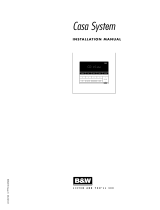CASA active speaker cabinets User Manual
Setting up
Position your CASA active speaker cabinet(s) on a stable surface capable of supporting the load and vibrations
from the cabinet or ideally on a strong 35mmØ pole mount or speaker stand with an adequate safe working
load to support the cabinet.
Aim the cabinet towards the audience or listeners and not in direct line of sight with any microphones that are
connected to the sound system. This is to avoid feedback (howling or squealing caused by the microphone
“hearing” itself amplified)
If a mixing console is being used to control input sources, connect the output of the mixer to the CASA cabinet
LINE input (4) or MIC/LINE (6, 24) with “LINE” switch selected (14, 23) using XLR or 6.3mm jack connectors.
If the system is in stereo, then usually one CASA cabinet will serve the right-side output and another for the
left-side output. Normally, the volume of the CASA cabinet LINE input is turned up high and the output will be
controlled at the mixer.
For CASA-8A and CASA-10A models, a further input is provided for connecting and additional microphone or
instrument (e.g. guitar) to a 6.3mm jack input (25)
If a playback device (e.g. mp3 or CD player) is to be connected directly to the CASA cabinet, this is usually
connected to the CASA cabinet AUX input via L+R RCA connectors (5, 32)
If the inputs to the CASA speaker cabinet are to be linked onto a further active cabinet or amplifier, the mix of
all MIC/LINE/GUITAR/AUX inputs can be fed from the MIX OUT line output XLR to further equipment (7, 31)
When all necessary connections are made, finally connect the supplied IEC power cable (or equivalent) from
the mains power supply to the IEC power inlet on the CASA speaker cabinet, ensuring that the supply voltage
is as indicated on the CASA speaker unit (8, 33)
Operation
With all volume controls turned fully down, switch on the power to the CASA speaker cabinet.
The media player display will light up (1, 27), and a status LED will show that power is on (11, 21)
If a mixer is connected to the CASA speaker unit, ensure a signal is present, turn up the mixer output part
way and gradually increase the volume of the input that the mixer is connected to for checking the output
from the CASA speaker. If the sound is present and OK, turn down the mixer and turn up the CASA speaker to
the maximum required output and control the volume from the mixer.
The “SIG” LED will light to show when a signal is present, and a “CLIP” LED should only light briefly on the
loudest beats or transients. If this LED lights more continuously, it will be necessary to turn the volume
control(s) down to avoid overload (11, 21)
If a microphone is connected directly to the CASA speaker unit instead of a mixer, speak into the microphone
whilst gradually increasing the volume of the MIC input until the required sound level is reached.
For playback devices, with a track playing and the playback device volume turned up part way, gradually
increase the volume of the AUX or LINE input that the playback device is connected to so that the output can
be checked and increase to the required output level.
The CASA-8A, CASA-10A and CASA-12A cabinets have an inbuilt DSP which has 5 optimal settings for different
types of input or audio program material: Normal / DJ / Voice / Live / Flat. Although quite self-explanatory, it
is worth experimenting with each profile to find the ideal EQ and tone response for each application. Simply
turn the DSP rotary selector (12, 29) and the DSP setting indicator LEDs (3, 28) show which setting is active.






